Interface Electronics02 SPICEProf. Dr. Jörg Vollrath01 Introduction and basic properties |
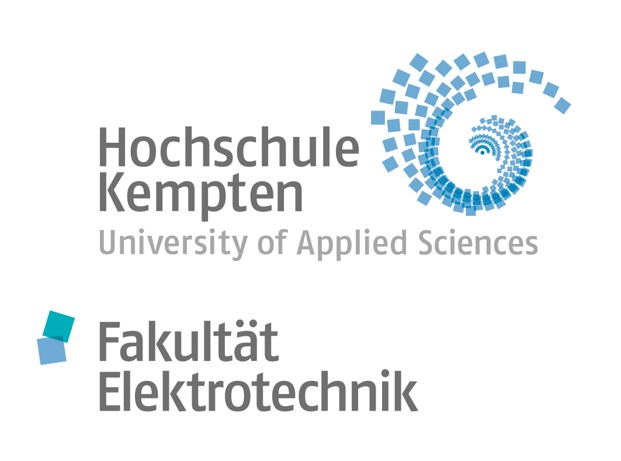
|
Video 2. lecture
|
Länge: 01:06:27 |
0:0:0 Review Introduction 0:0:44 Video recording 0:1:34 LTSPICE start 0:2:49 LTSPICE configuration white background and thick lines 0:5:13 Thick lines 0:7:29 Start schematic with resistor 0:8:44 Finished low pass placing parts 0:12:12 Values for components 0:12:44 Labels node names 0:13:19 Simulate .op 0:14:59 Turning a resistor changes polarity of current 0:16:12 Simulate .dc voltage ramp 0:17:1 Add trace to graph 0:18:44 Sine voltage at source 0:19:44 Transient simulation .tran 0:20:30 Graph discussion 0:21:6 Higher frequency 0:22:36 AC simulation, voltage source and command 0:24:14 Graph discussion 0:25:6 Corner frequency 0:26:56 Context sensitive menues 0:27:36 Measure command .MEAS 0:28:54 Verification of result 0:30:13 Data converter schematic 4 Bit DAC 0:31:36 Copying SPICE code to local drive 0:32:36 Copying subcircuits .asc .asy 0:33:56 ADC circuit download 0:34:37 ADC DAC test circuit 0:35:33 Explanation test circuit 0:36:33 Hierarchie 0:37:18 Sample and hold 0:38:43 .Save command 0:40:13 16 steps 0:41:53 Voltage probe 0:42:23 High frequency sampling 0:44:25 12 Bit test circuit 0:45:58 Tools for data processing and analysis 0:47:28 Webreport 0:48:28 Directories and files 0:51:1 Presentation and handout mode 0:51:33 Editor 0:53:28 HTML tags 0:55:11 LTSPICE schematics from files 0:57:44 Equations with MathJax 0:58:19 Animations 0:59:53 Insert images 1:1:33 Copy, paste, modify |
Overview
CMOS: Circuit Design, Layout and Simulation, Baker, Chap1, p.8-29 |
SPICE
|
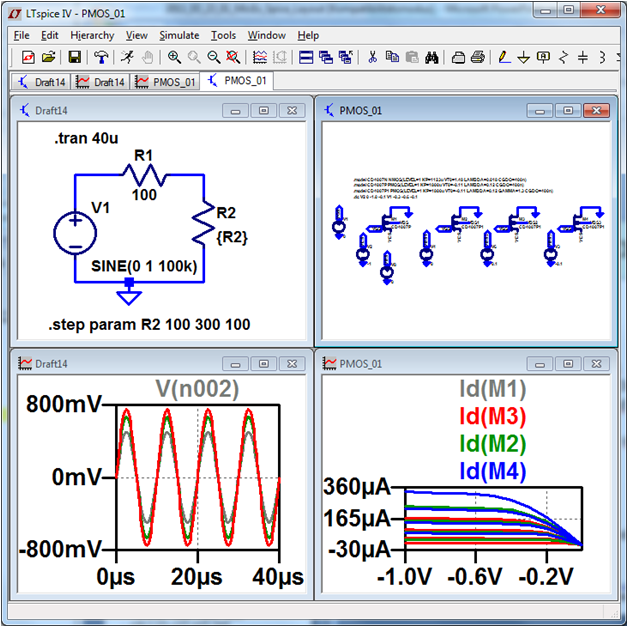
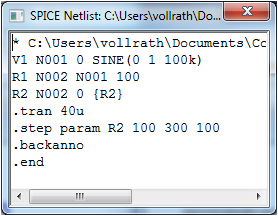
|
LTSPICE netlist
View, SPICE netlist* C:\Programme\LTC\LTspiceIV\Draft1.asc
V1 N001 0 1
R1 N002 N001 50
R2 N002 0 50
.dc V1 0 2 0.1
.backanno
.end
V is a voltage source
N001, N002 node names
.dc simulation instruction
SPICE Elements
- Voltage source
- DC voltage: V<name> <node1> <node2> <value>
- AC voltage:
SIN <offset> <amplitude> <frequency> [<delay>] - LTSPICE: Menue Edit, Component, Voltage
- Current source
- like voltage, but starting with I
- Resistance
- R<name> <node1> <node2> <value>
- Capacitance
- C<name> <node1> <node2> <value>
- Inductance
- L<name> <node1> <node2> <value>
- Modifiers: m (10-3), u(10-6), k(103), MEG(106)
SPICE simulation statements
- Operating point (voltage, current)
- .op
- Variation of a source
- .dc <sourcename> <startvalue> <endvalue> <step>
- Variation of multiple parameters
- .dc statement with multiple elements
- .dc VDS 0 5 1m VGS 0 5 1
- Transient simulation(time)
- .tran <tstep> <tstop> [<tstart> <tmax>]
- Transferfunction
- .TF V(<node1>,<node2>) Vin
- .TF I(<Elementname>)
- Bodeplot
- .ac <dec> <Npoints> <startfrequency> <EndFreq>
LTSPICE: First Steps
|
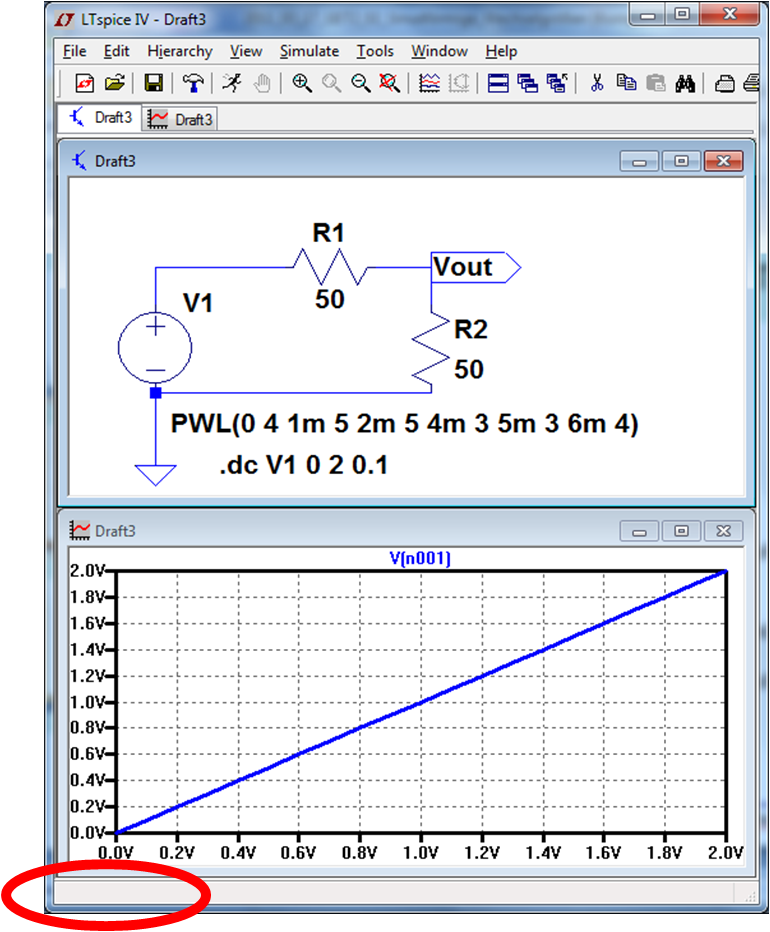
|
LTSPICE: Configuration
|
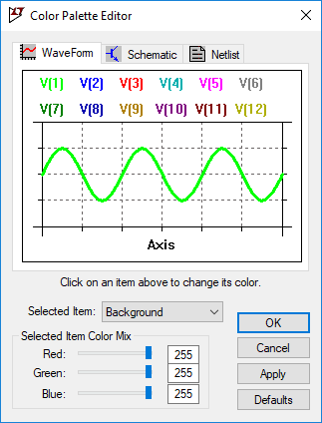
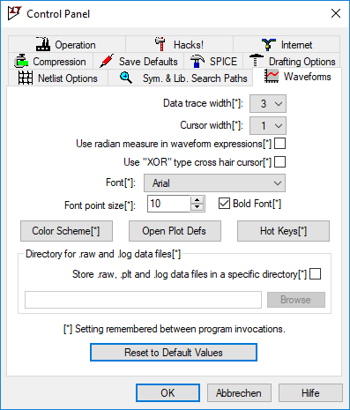
|
Example Voltage divider operation point: .op
Schematic
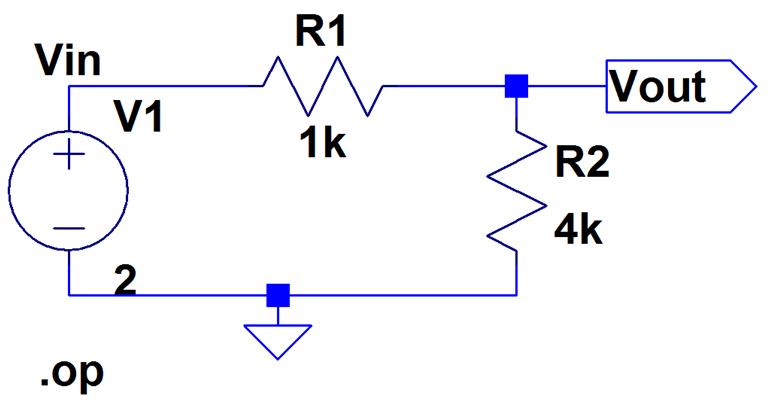
|
Netlist
|
Voltage source variation: .dc Vin 0 1 1m
Schematic 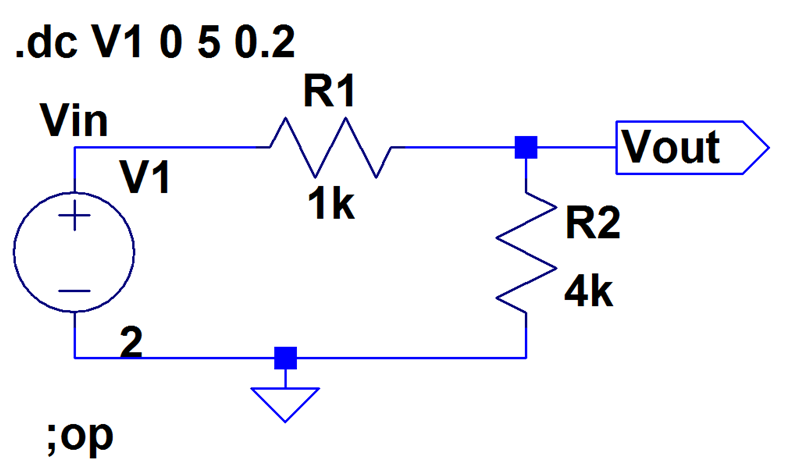
|
Netlist
|
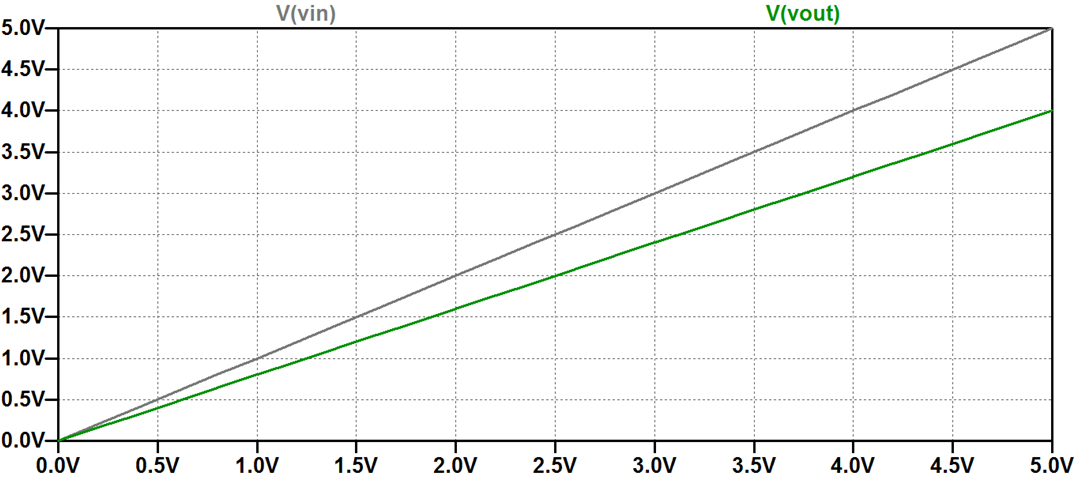
SPICE: Sinusodial source
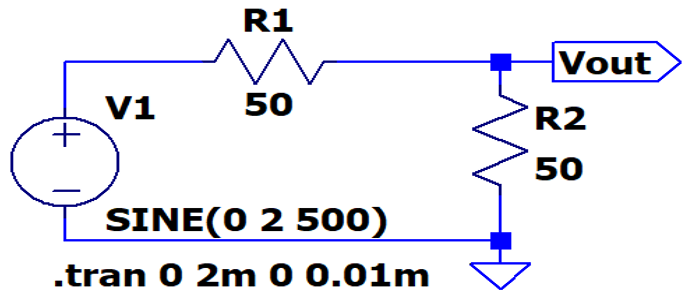
|
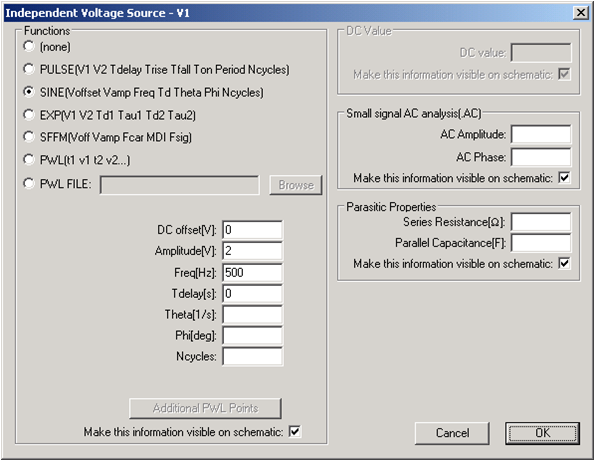
|
Transient simulation: .tran 1n 3u
Schaltplan 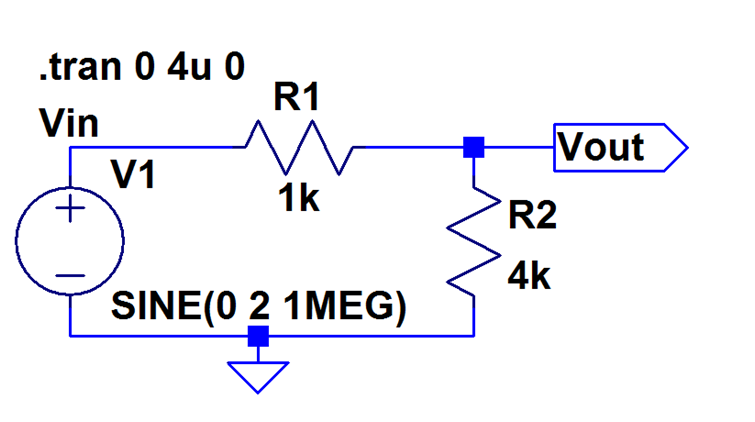
|
|
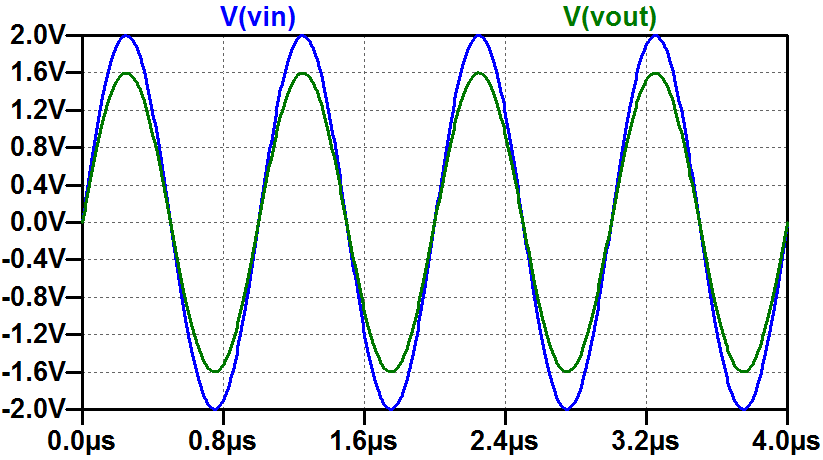
MOSFET transistors in LTSPICE
Netlist:M1 NDrain NGate NSource PBulk NMOSModel
M2 PSource PGate PDrain PBulk PMOSModel
.model NX NMOS(LEVEL=1 KP=300u
+ VT0=0.8 LAMBDA=0.000 CGDO=400n)
.lib C:\Program Files (x86)\LTC\LTspiceIV\lib\cmp\standard.mos
.include cmosedu_models.txt
Example:
M1 VD VG VS VB N_50nm
The transistor model N_50nm can be specified in a model statement (.model), can be supplied in a library file (.lib) or in an external file (.include)
Symbol:
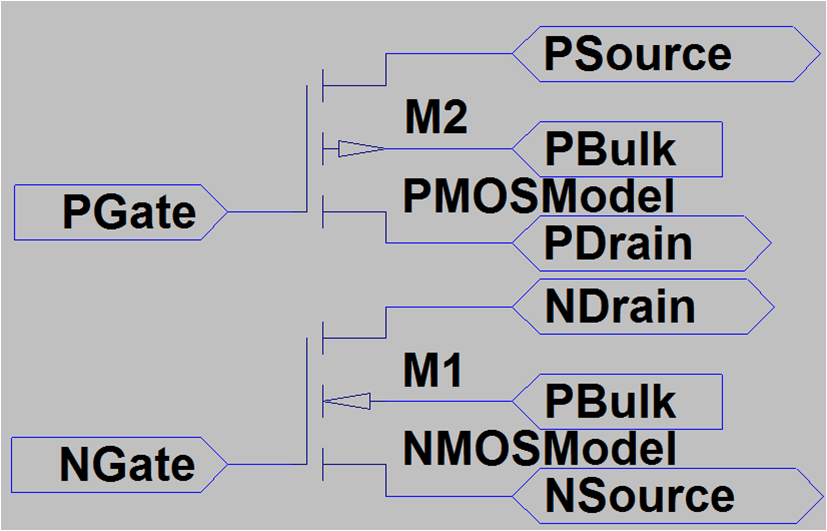
Transistor model
cmosedu_models.txt| Simple model | Detailed model |
.MODEL N_1u NMOS LEVEL = 3 + TOX = 200E-10 NSUB = 1E17 GAMMA = 0.5 + PHI = 0.7 VTO = 0.8 DELTA = 3.0 + UO = 650 ETA = 3.0E-6 THETA = 0.1 + KP = 120E-6 VMAX = 1E5 KAPPA = 0.3 + RSH = 0 NFS = 1E12 TPG = 1 + XJ = 500E-9 LD = 100E-9 + CGDO = 200E-12 CGSO = 200E-12 CGBO = 1E-10 + CJ = 400E-6 PB = 1 MJ = 0.5 + CJSW = 300E-12 MJSW = 0.5 |
.model N_50nm nmos level = 54 +binunit = 1 paramchk= 1 mobmod = 0 +capmod = 2 igcmod = 1 igbmod = 1 geomod = 1 +diomod = 1 rdsmod = 0 rbodymod= 1 rgatemod= 1 +permod = 1 acnqsmod= 0 trnqsmod= 0 +tnom = 27 toxe = 1.4e-009 toxp = 7e-010 toxm = 1.4e-009 +epsrox = 3.9 wint = 5e-009 lint = 1.2e-008 +ll = 0 wl = 0 lln = 1 wln = 1 +lw = 0 ww = 0 lwn = 1 wwn = 1 +lwl = 0 wwl = 0 xpart = 0 toxref = 1.4e-009 +vth0 = 0.22 k1 = 0.35 k2 = 0.05 k3 = 0 +k3b = 0 w0 = 2.5e-006 dvt0 = 2.8 dvt1 = 0.52 +dvt2 = -0.032 dvt0w = 0 dvt1w = 0 dvt2w = 0 +dsub = 2 minv = 0.05 voffl = 0 dvtp0 = 1e-007 +dvtp1 = 0.05 lpe0 = 5.75e-008 lpeb = 2.3e-010 xj = 2e-008 +ngate = 5e+020 ndep = 2.8e+018 nsd = 1e+020 phin = 0 +cdsc = 0.0002 cdscb = 0 cdscd = 0 cit = 0 +voff = -0.15 nfactor = 1.2 eta0 = 0.15 etab = 0 +vfb = -0.55 u0 = 0.032 ua = 1.6e-010 ub = 1.1e-017 +uc = -3e-011 vsat = 1.1e+005 a0 = 2 ags = 1e-020 +a1 = 0 a2 = 1 b0 = -1e-020 b1 = 0 +keta = 0.04 dwg = 0 dwb = 0 pclm = 0.18 +pdiblc1 = 0.028 pdiblc2 = 0.022 pdiblcb = -0.005 drout = 0.45 +pvag = 1e-020 delta = 0.01 pscbe1 = 8.14e+008 pscbe2 = 1e-007 +fprout = 0.2 pdits = 0.2 pditsd = 0.23 pditsl = 2.3e+006 +rsh = 3 rdsw = 150 rsw = 150 rdw = 150 +rdswmin = 0 rdwmin = 0 rswmin = 0 prwg = 0 +prwb = 6.8e-011 wr = 1 alpha0 = 0.074 alpha1 = 0.005 +beta0 = 30 agidl = 0.0002 bgidl = 2.1e+009 cgidl = 0.0002 +egidl = 0.8 +aigbacc = 0.012 bigbacc = 0.0028 cigbacc = 0.002 +nigbacc = 1 aigbinv = 0.014 bigbinv = 0.004 cigbinv = 0.004 +eigbinv = 1.1 nigbinv = 3 aigc = 0.017 bigc = 0.0028 +cigc = 0.002 aigsd = 0.017 bigsd = 0.0028 cigsd = 0.002 +nigc = 1 poxedge = 1 pigcd = 1 ntox = 1 +xrcrg1 = 12 xrcrg2 = 5 +cgso = 6.238e-010cgdo = 6.238e-010 cgbo = 2.56e-011 cgdl = 2.495e-10 +cgsl = 2.495e-10 ckappas = 0.02 ckappad = 0.02 acde = 1 +moin = 15 noff = 0.9 voffcv = 0.02 +kt1 = -0.21 kt1l = 0.0 kt2 = -0.042 ute = -1.5 +ua1 = 1e-009 ub1 = -3.5e-019 uc1 = 0 prt = 0 +at = 53000 +fnoimod = 1 tnoimod = 0 +jss = 0.0001 jsws = 1e-011 jswgs = 1e-010 njs = 1 +ijthsfwd= 0.01 ijthsrev= 0.001 bvs = 10 xjbvs = 1 +jsd = 0.0001 jswd = 1e-011 jswgd = 1e-010 njd = 1 +ijthdfwd= 0.01 ijthdrev= 0.001 bvd = 10 xjbvd = 1 +pbs = 1 cjs = 0.0005 mjs = 0.5 pbsws = 1 +cjsws = 5e-010 mjsws = 0.33 pbswgs = 1 cjswgs = 3e-010 +mjswgs = 0.33 pbd = 1 cjd = 0.0005 mjd = 0.5 +pbswd = 1 cjswd = 5e-010 mjswd = 0.33 pbswgd = 1 +cjswgd = 5e-010 mjswgd = 0.33 tpb = 0.005 tcj = 0.001 +tpbsw = 0.005 tcjsw = 0.001 tpbswg = 0.005 tcjswg = 0.001 +xtis = 3 xtid = 3 +dmcg = 0e-006 dmci = 0e-006 dmdg = 0e-006 dmcgt = 0e-007 +dwj = 0.0e-008 xgw = 0e-007 xgl = 0e-008 +rshg = 0.4 gbmin = 1e-010 rbpb = 5 rbpd = 15 +rbps = 15 rbdb = 15 rbsb = 15 ngcon = 1 |
Transistor measurement
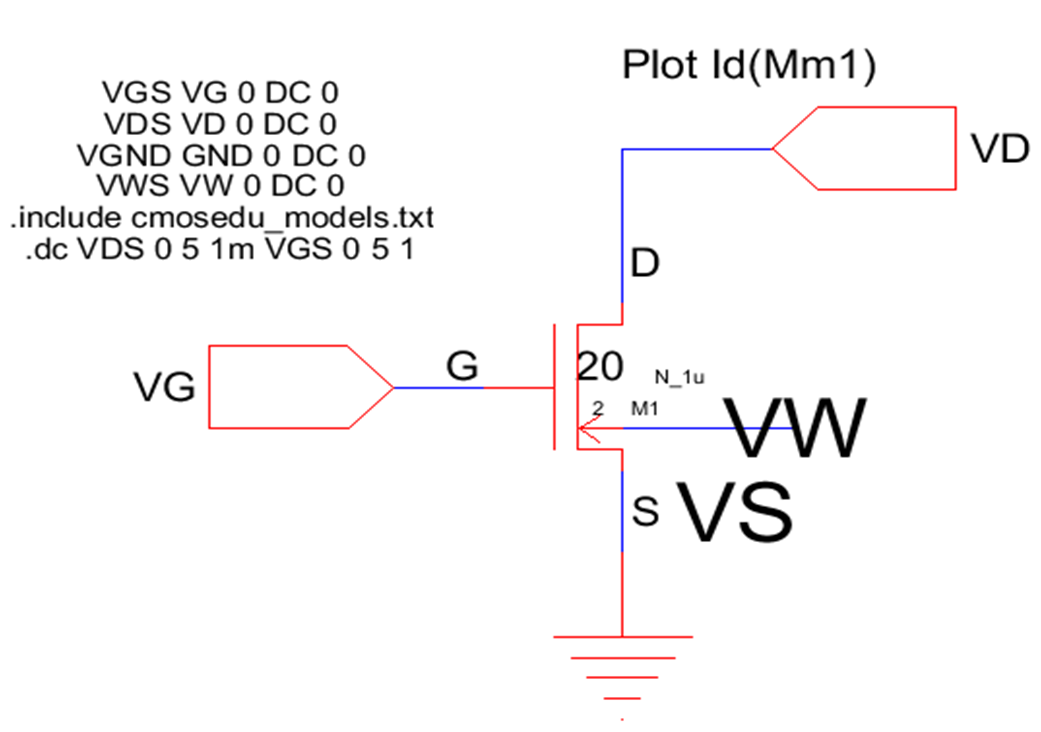
LTSPICE: Hierarchy
|
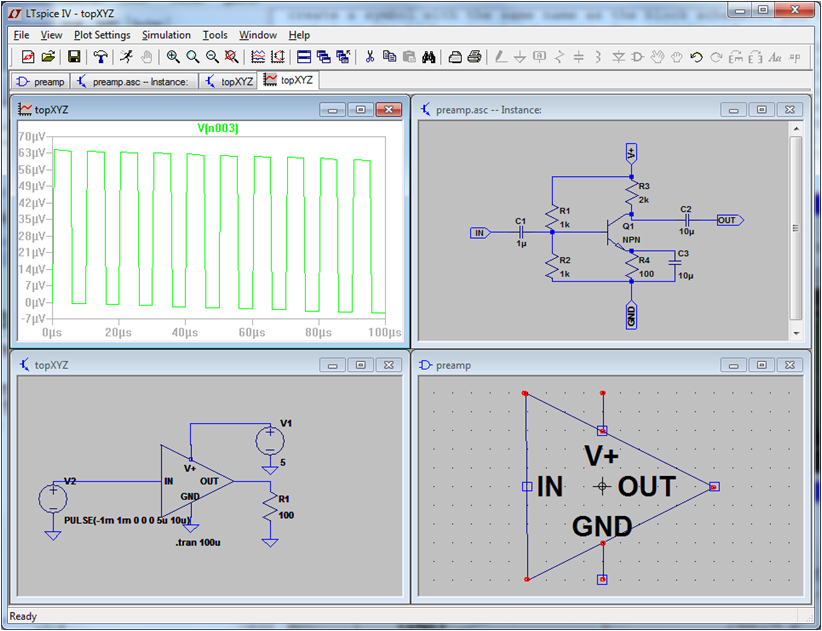
|
Hierarchy
SPICE directive in Netlist.model CN NMOS(LEVEL=1 KP=11m VT0=1 LAMBDA=0.018 CGDO=400n)Make a voltage node (VDD) available
.global VDDInclude device models or subcircuits
.include cmosedu_models.txt
A Circuit can be reused
Nodes to be connected externally need to be set as input and output: label net
A symbol needs to be created: Hierarchy, Open this Sheets symbol
Insert this circuit using Edit, Components and select a local directory to make locally defined cirucits visible.
Use of a subcircuit is shown starting with X in netlist. Definition starts with .subckt and ends with ends name.
XX1 IN D7 IN1 pipestageinv
* block symbol definitions
.subckt pipestageinv In Dout Vout
M1 N001 In 0 0 CN
…
ends pipestageinv
Input waveforms and measurement
|
Waveforms VA A 0 PWL file=a.txt VB B 0 PWL file=B.txt VC Ci 0 PWL file=C.txt a.txt 0n 0 9n 0 10n 1 19n 0 20n 1 29n 1 30n 0 |
Calculation of average and rms value Select the legend of a curve in the Waveformwindow. < strg > Mouse left click Measurement of time: .Measure TAX00 WHEN V(ax)=0.5 FALL=1 .Measure TY101 WHEN V(y1)=0.5 RISE=1 .Measure DY101 PARAM (TY101-TAX00)*1E12 Result name: TAX00 Time when voltage of node ax is 0.5V and ax is the first falling edge. |
Hilfe LTSPICE für Temperaturvariation: Suchbegriff R, TEMP
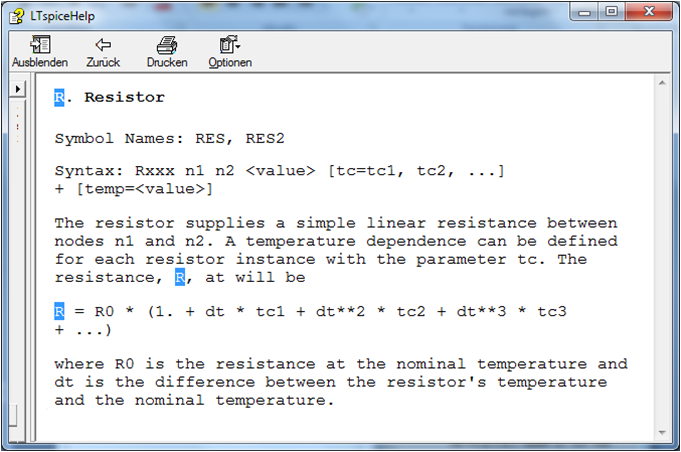
Simulation with varying components
|
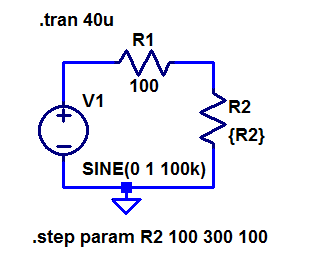
|
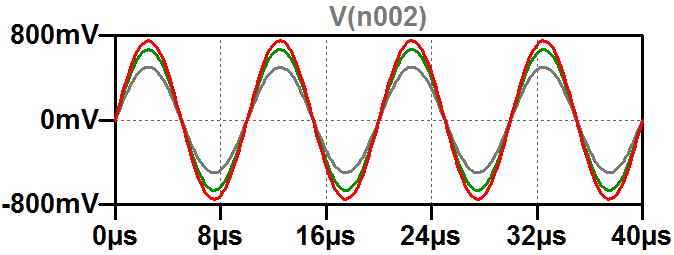
Behavioral data converter simulation
- Behavioral simulation: voltage controlled voltage sources (bv)
Simple mathematical equation - Inputs and Outputs:
Data D0..DN-1, Vin or Vout
time discrete: clock, sample and hold (switch and capacitance) - Time simulation:
Ramp or sine
All possible codes
FFT: number of samples power of 2: 2N+4
+4 for accuracy and sine function.
Sine signal prime number of periods
Example: 20 Bit ADC, fs = fclk = 100 MHz, Range 0..1 V, Vref = 1V
Simulation time: tsim = 2 20 + 4 /100MHz = 16M/100M s = 0.16777216s
Signal sine frequency: fsig = prime / tsim
Behavioral data converter simulation
| Bits | LSB | Simulation time: tsim |
signal frequency: fsig |
LTSPICE run time | LTSPICE output file size | FFT points | Comment |
| 20 | 1 μ V | 167.77216ms | 65.56510925 Hz | 167.7ms/1.2us/s = 100 000s = 30 h | 2MB/us => 600 GB minimal; 4600s => 6ms => 7.8GB | ||
| 16 → 98 dB | 16 μ V | 220 * 10 ns = 10.48576 ms | \( \frac{11}{t_{sim}} = 1049.04174804687 Hz \) | 8467s = 2.5 h | 900 MB | \( 2^{20} = 1048576 \) → 57dB | LTSPICE can't draw curve, but can load data and do FFT |
| 12 | 256 μ V | 216 * 10 ns = 655.36 µs | \( \frac{11}{t_{sim}} = 16784.66796875 Hz \) | 378s =7 min | 65 MB | \( 2^{16} = 65536 \) | |
| 8 | |||||||
| 4 → 26 dB | 62.5 mV | 28 * 10 ns = 2.560 µ s | \( \frac{11}{t_{sim}} = 4296875 Hz \) | 1.4 s | 500 kB | \( 2^{8} = 256 \) → |
.save dialog
.save V(in) V(d*) V(Vout)
This saves only V(in), all data channels and Vout and reduces the file size significantly.
; option can limit saved data
.option numdgt=12
precision of saved data
To be able to use simulated data for FFT with high precision use the following option:
.options plotwinsize=0
Scalable behavioral 4 Bit DAC
|
Behavioral voltage source BV with equation V=V(in1)/16+V(D3)/2+V(D2)/4+V(D1)/8+V(D0)/16 Scalable DAC takes input signal In1 as high resolution input and adds D3..D0 information. For high resolution more modules can be combined. |
Scalable behavioral 4 Bit ADC
|
Behavioral voltage source BV Rounding function: V(D3) = round(V(IN)) V(D2) = round(V(IN)*2-V(D3)) ... Residue: V(Out) = V(in)*16-V(D3)*8-V(D2)*4-V(D1)*2-V(D0) Residue allows extending the ADC for high resolution. |
Test for 4 Bit ADC and DAC
|
A 4 Bit ADC and DAC test can be simulated in LTSPICE. The output file size can be limited by using the .save dialog option. The output shows the step size of the digitalisation. 
|
Test for 12 Bit ADC and DAC
|
A 12 Bit ADC and DAC test can still be simulated in LTSPICE.
The output file size can be limited by using the .save dialog option. FFT 65k points gives: signal: -9dB, noise level: -116dB Calculation: 6.07 * B dB + 1.76 dB + 10 log(N/2) dB = 6.07 * 12 dB + 1.76 dB + 10 log(65k/2) dB = 72 dB + 1.76 dB + 45 dB = 119 dB 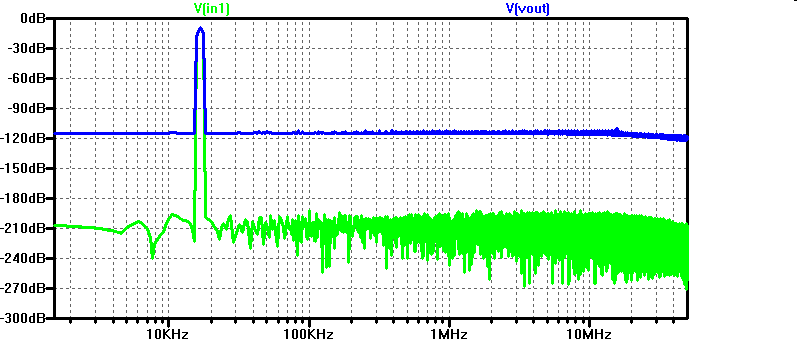
|
Analyzing this data with
Read LTSPICE raw file for data converter analysis.
with Start = 0, Stop = 655.36E-6, Step 10E-6
and procesing integer values with
FFT and INL, DNL data converter analysis
gives you less SQNR than expected due to sample and hold circuits distroting the residue.
A comparison of the signals res0 and vout0, res1 and vout1 shows the performance of the circuit. The signals should be identical.
It is unclear why the FFT in LTSPICE is not showing this.
A comparison of the signals res0 and vout0, res1 and vout1 shows the performance of the circuit. The signals should be identical.
It is unclear why the FFT in LTSPICE is not showing this.
Improved Test for 12 Bit ADC and DAC
|
A 12 Bit ADC and DAC test can still be simulated in LTSPICE.
The output file size can be limited by using the .save dialog option. Sample and hold circuits are only used at the input and output. Javascript FFT 16k points gives: signal: 84.3dB, noise level: 8.56dB Calculation: 6.07 * B dB + 1.76 dB + 10 log(N/2) dB = 6.07 * 12 dB + 1.76 dB + 10 log(16k/2) dB = 72 dB + 1.76 dB + 40 dB = 119 dB 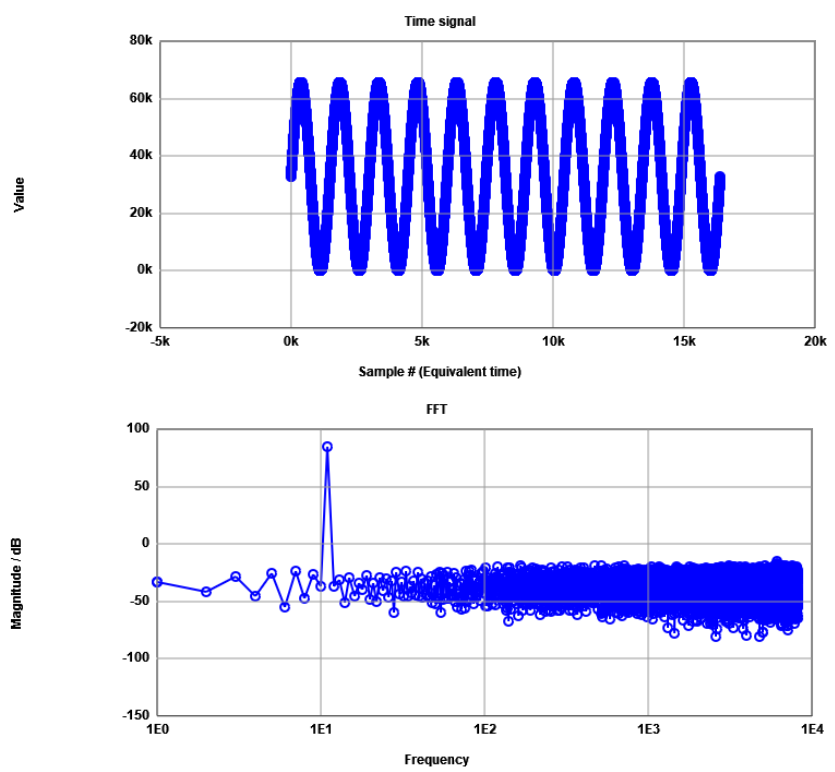
|
Start time 0, Stop time 655.36E-6, Time step 40E-9 gives 16384 data points.
Mapping this with a scale of 65535 to integer prepares analysis with Javascript FFT.
Mapping this with a scale of 65535 to integer prepares analysis with Javascript FFT.
Test data analysis
LTSPICE raw data file size reduction
LTSPICE data can be reduced with a .save statement.
Reading LTSPICE raw data via a web page
Read LTSPICE raw file for data converter analysis.
Data converter analysis via a web page
FFT and INL, DNL data converter analysis.
ADC Calibration
There is an option to do calibration before.
LTSPICE raw data file size reduction
LTSPICE data can be reduced with a .save statement.
.save V(vout)
The simulation of the 12-bit ideal ADC and DAC gives for 11 periods sine simulation running 5 min in LTSPICE generating 4 million points and 48 MB file size.
This file can be loaded into Matlab with a LTspice2Matlab code (watch out for UTF8 versus UTF16 encoding).
Adapt lines in the code accordingly:
153 - fid = fopen(filename, 'rb', 'n', 'UTF16LE');
156 - fid = fopen(sprintf( '%s.raw', filename ), 'rb', 'n', 'UTF16LE');
Reading LTSPICE raw data
It can also be processed on a web page:
Read LTSPICE raw file for data converter analysis.
Before reading the data choose a time step of 10E-9 to get data for each conversion step.
Choose a range of at least 65536 to get at least 16 bit for further processing.
After browsing for the file it takes quite some time, a couple of minutes, in Firefox until data is loaded and converter.
More then 65k points are generated.
Data converter analysis
Another web page will do the analysis:
FFT and INL, DNL data converter analysis.
First data is copied to the text input field.
Then read integer data is done.
Finishing with Generate charts.
FFT, INL and DNL are displayed. Further down on the page signal to noise is displayed.
ADC Calibration
A calibration file based on a positive input ramp can be loaded before to compensate for errors.
Load integer data into the input data field, read integer data and do a code calibration eliminating missing codes, or a code and slope calibration also compensating for non linearities.
After calibration is set, proceed with sine data for FFT, INL and DNL.
Hochschule für angewandte Wissenschaften Kempten, Jörg Vollrath, Bahnhofstraße 61 · 87435 Kempten
Tel. 0831/25 23-0 · Fax 0831/25 23-104 · E-Mail: joerg.vollrath(at)fh-kempten.de
Impressum